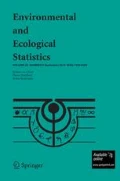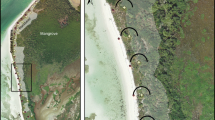Abstract
Line transect sampling is an effective survey method for estimating butterfly densities because it provides unbiased estimates of site-density (provided key assumptions are met), and estimates are comparable among sites. For monitoring Karner blue butterflies in Wisconsin, USA, comparable estimates are required because each year a different selection of sites will be monitored. Annual state-wide indices of species abundance can be derived from the site-surveys and compared to previous year's indices to monitor trends. We advocate that line transect sampling is preferable to Pollard-Yates transects as a survey technique for monitoring Karner blue butter- flies. The Pollard-Yates surveys do not adjust for diferences in site detectability. As a consequence, estimates of among-site from Pollard-Yates surveys can be biased. © Rapid Science 1998
Similar content being viewed by others
References
Akaike, H. (1973) Information theory and an extension of the maximum likelihood principle, in International Symposium on Information Theory 2nd ed. (B.N. Petran and F. Csàaki, eds), 267–81, Akadéemiai Kiadi, Budapest, Hungary.
Bleser, C.A. (1993) Status survey, management and monitoring activities for the Karner Blue Butterfly (Lycaeides melissa samuelis) in Wisconsin, 1990–1992. Report to the US Fish and Wildlife Service, North Central Regional Office, Federal Bldg, Fort Snelling, Twin Cities, MN 55111, USA.
Brown, J.A. and Boyce, M.S. (1996) Monitoring Karner blue butterflies (Lycaeides melissa samuelis) for the proposed Habitat Conservation Plan, Wisconsin. Report to the US National Fish and Wildlife Foundation, Main Interior Bldg., 18th and C Streets, Rm 2556, Washington, DC 20240, USA.
Buckland, S.T., Anderson, D.R., Burnham, K.P. and Laake, J.L. (1993) Distance Sampling: Estimating Abundance of Biological Populations. Chapman & Hall, London.
Clough, M.W. (1992) Endangered and threatened wildlife and plants; determination of endangered status for the Karner blue butterfly. Department of the Interior, Fish and Wildlife Service, Federal Register vol. 57, no. 240, December 14 1992.
Givnish, T.J., Menges, E.S. and Schweitzer, D.F. (1988) Minimum area requirements for longterm conservation of the Albany Pine Bush and Karner blue butterfly: An assessment. Proposed research program, Botany Department, University of Wisconsin, Madison, WI 53706.
Greenstone, M.H. (1979) A line transect density index for wolf spiders (Pardosa spp.), and a note on the applicability of catch per unit effort methods to entomological studies. Ecological Entomology, 4, 23–29.
Hewson, R. (1974) Line transect counts of bees on heather moorland in north-east Scotland. Entomologist's Monthly Magazine, 109, 198–201.
King, R.S. (1997) Daily movements and dispersal patterns of Karner blue butterflies in oak barrens habitat at Necedah National Wildlife Refuge. Preprint. US Fish and Wildlife Service, Necedah National Wildlife Refuge, W7996 20th Street W, Necedah, WI 54646– 7531, USA.
Laake, J.L., Buckland S.T., Anderson, D.R. and Burnham, K.P. (1993) DISTANCE User Guide. Colorado Cooperative Fish and Wildlife Research Unit, Colorado State University, Fort Collins, CO 80523, USA.
Moss, D. and Pollard, E. (1993) Calculation of collated indices of abundance of butterflies based on monitored sites. Ecological Entomology, 18, 77–83.
Pollard, E. (1977) A method for assessing changes in the abundance of butterflies. Biological Conservation, 12, 115–24.
Pollard, E. and Yates, T.J. (1993) Monitoring Butterflies for Ecology and Conservation. Chapman & Hall, London.
Pollard, E., Elias, D.O. Skelton, M.J. and Thomas, J.A. (1975) A method of assessing the abundance of butterflies in Monks Wood National Nature Reserve in 1973. Entomologists Gazette, 26, 79–88.
Spalding, A. (1997) The use of the butterfly transect method for the study of the nocturnal moth Luperina nickerlii leechi Goater (Lepidoptera:Noctuidae) and its possible application to other species. Biological Conservation, 80, 147–52.
Sparrow, H.R., Sisk, T.D., Ehrlich, P.R., and Murphy, D.D. (1994) Techniques and guidelines for monitoring neotropical butterflies. Conservation Biology, 8, 800–9.
Thomas, J.A. (1983) A quick method for estimating butterfly numbers during surveys. Biological Conservation, 27, 195–211.
Author information
Authors and Affiliations
Rights and permissions
About this article
Cite this article
Brown, J.A., Boyce, M.S. Line transect sampling of Karner blue butterflies ( Lycaeides melissa samuelis). Environmental and Ecological Statistics 5, 81–91 (1998). https://doi.org/10.1023/A:1009620105039
Issue Date:
DOI: https://doi.org/10.1023/A:1009620105039




